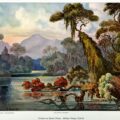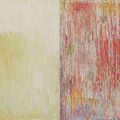Ted Kooser’s Celebration of Metaphor

In Ted Kooser’s newest book of poems, Cotton Candy, the poet challenges us to consider what constitutes poetry in the deepest sense of purpose and, yes, meaning. In a postmodern climate in which the “rules” of poetry have been largely abolished, the techniques that Kooser employs—an embodied first-person, figurative language, and especially metaphor—might be considered old school. Undoubtedly, some readers will rebuff Kooser’s use of the pathetic fallacy, preferring a conservatory treatment of nature as separate from humanizing characteristics. But the theories behind his use of the extended metaphor merit a closer look.
This slim, understated volume certainly conveys allegiance to the traditional portrayals of image-based poetry, seemingly eschewing portrayals of social and political realities of today, as well the notion that language determines the meaning, not the subject, and that invention is more of an evasion of reality than it is a revelation. Ever the master of metaphor, Kooser consistently points out to us what is magical about vision, rootedness, and curiosity. As he writes in his prose memoir, Local Wonders, he aptly exposes what is lacking in a culture of entitlement that rewards profits over appreciation: “[I]f you can awaken / inside the familiar / and discover it new / you need never / leave home.” Ted Kooser’s poetry is as Emersonian, though without the same spiritual grandeur.His work transforms the world we are given into a world that we create.
Cotton Candy is a compilation of poems written in the last three years, but it is also a celebration of work—that the poet is genuinely working each day and never stops learning. In fact, Cotton Candy began as a book to teach metaphor to students. Kooser’s accessibility is something that draws a popular audience to his poems, but that is not to say his poems are not filled with complex layers of meaning. Kooser presents extended metaphors that demonstrate the ephemeralness of nature. He describes his intention in all of these poems, composed daily and in solitude, “to snatch [the poem] out of the air in words, rhythms, and cadences, the way a cotton candy vendor dips an airy puff out of a cloud of spun sugar, and hands it to his customer.” The shadow of mortality is evident throughout the poems, but the poems still amuse and return us to our childhood wonder.
Let us take a closer look at Kooser’s parade of extended metaphors: “As far as I can see, across the city, / quill pens of smoke are dipping their tips / into the inkwells of chimneys /. . . or [t]he tarp worn thin by hard use / thrown over days. . .” In metaphorical thinking, objects are conceptualized side by side. Then, through a synthesizing process, they are reconstructed to create new concepts or ideas, to see each within the other. Forming similes and extended metaphors demands a rapid amendment of reality and the combination of dissociated items.
These produce patterns within the writing intelligence, imposing a rational order on an otherwise irrational set of circumstances. This involves conceiving two entities occupying the same space, which leads to new identities, such as the “little goldfish spots of sunlight” or “ tattered wings of shadow.” Kooser’s metaphors take us into their parallel universes. They suspend our disbelief that such a world could exist. As Kooser writes in an essay on faith and metaphor: “the tenor of my religious experience is my sense that there is something there, beyond us and around us and within us, some great power.”
In Kooser’s poetry, metaphor allows the reader to be privy to their own unconscious interior life, revealing seemingly incompatible aspects of their own thoughts. As he commented on an earlier poem, “Etude”: “Of my poems of metaphor, and there are so many, I like the ones that leap the furthest and makes the most distant (and perhaps peculiar) connections. I use it with students sometimes to show how once the metaphor has taken flight it must at last be brought back to ground.”
Cotton Candy opens with the titular poem describing the vendor, who would “select one paper cone from a big bouquet / of identical cones kept ready in a bucket /. . . and sweep it deep in the whirling pink strands of / warm sugar.” The confection of the cotton candy is transformed into “one cloud for each of us” and the cloud is then compared to a “small pink balloon,” offering two levels of metaphorical thinking. Superimposition, acute as it is in Emily Dickinson, works toward greater condensation. Therefore, the pink cloud is transformed into a pink “balloon,” which shares characteristics with the cloud, spurring on the final conceit in which it is the cloud and the balloon carry the children with their buoyancy rather than the children carrying them. The metaphor unites the whole, and the poem ends by tying things up in a bounded space.
In the poem “Spider,” the poet creates a simile for the tiny black spider as “an umbrella skittering in/ from the side.” Having made this correlation, he studies it through other similes associated with seeking protection or cover: the spider wanting to rest in the “shade of [his] shoe, or a sizeable cloud” as if the spider’s agitation embodies human feelings of threat or boredom. After trying to stay in the dark of the shade to remain undetected, the spider hops back into the light, “the tips of its spokes scarcely touching at all.” This complicates the extended metaphor in the title poem by going deeper into the mutual mindsets of the speaker and the spider.
Kooser’s poetry is notable for its sparse but elegant diction. His poetry invites us to imagine a complicated man who would probably refer to himself as a simple person. He writes about nothing that is not there under his nose. He tells you what is there because it is sufficient for living. A little wit, a little sentiment, a light from a single lamp. Basic good sense. What he sees is not his, but its own truth.
I can think of no better poem in the book to close with than his last poem: “A Special Kind of Sunset” as the poet grounds us looking up to those “rare sunsets / when the light squeezes in under a low layer of clouds / and illuminates everything. . . / What’s left / of that day has paused, turned, and come back, and is / lifting the lid just a little to be sure we’re still there.” This is vintage Kooser, reversing perspectives by projecting us (the readers) into the sky, a light resurging under the clouds just as the sun is beginning to set. We are then left to wonder if the sky is making sure we’re still here or if we’re making sure the sky is. This is a beautiful way to affirm both endings, beginnings, and the metaphors that unite them.
About Judith Harris
Judith Harris is the author of Atonement and The Bad Secret (LSU Press), Night Garden (Tiger Bark Press), and Signifying Pain (SUNY Press). Her poems have appeared in The Nation, The Atlantic, The New Republic, Slate, The Hudson Review, American Life in Poetry, and NPR. Her articles and reviews have appeared in AWP Chronicle, The American Journal of Psychoanalysis, On the Seawall, and Midwest Quarterly. A new book, The Poetry of Loss: Grief in Romantic and Contemporary Elegies. is due out with Routledge in 2023.





